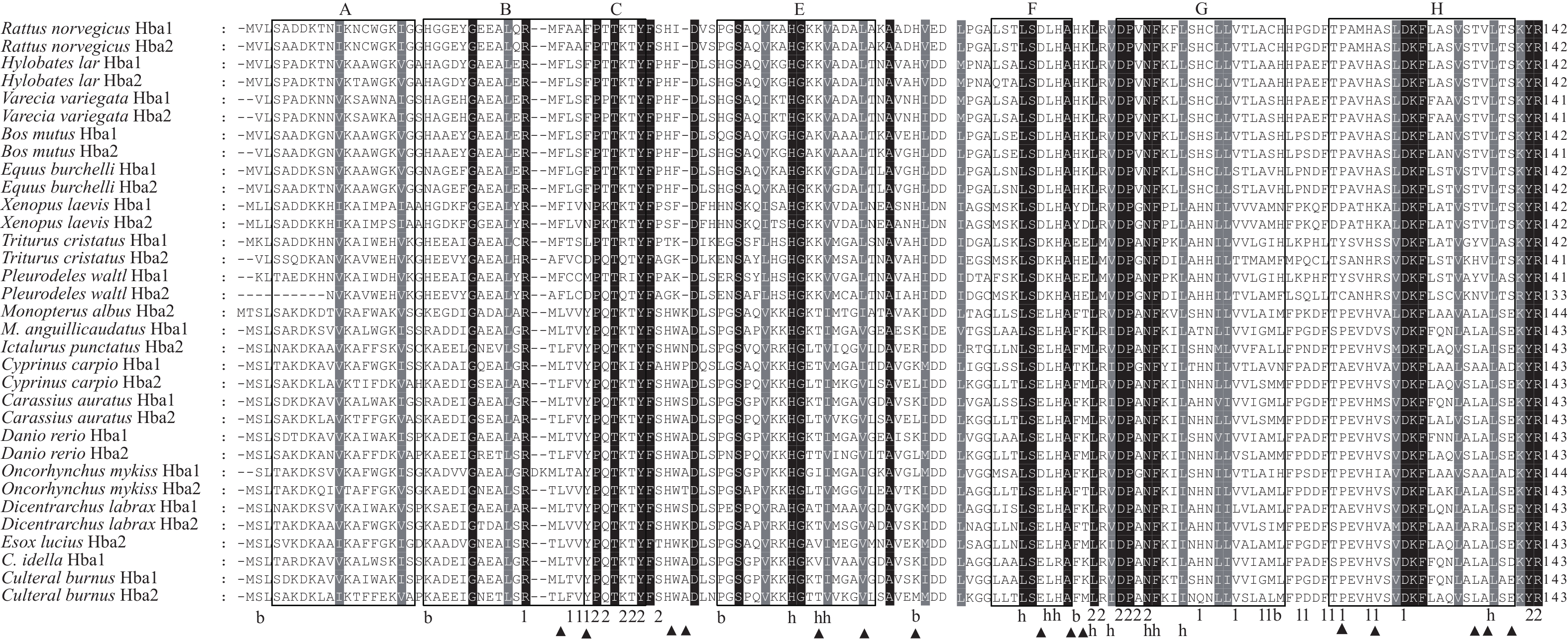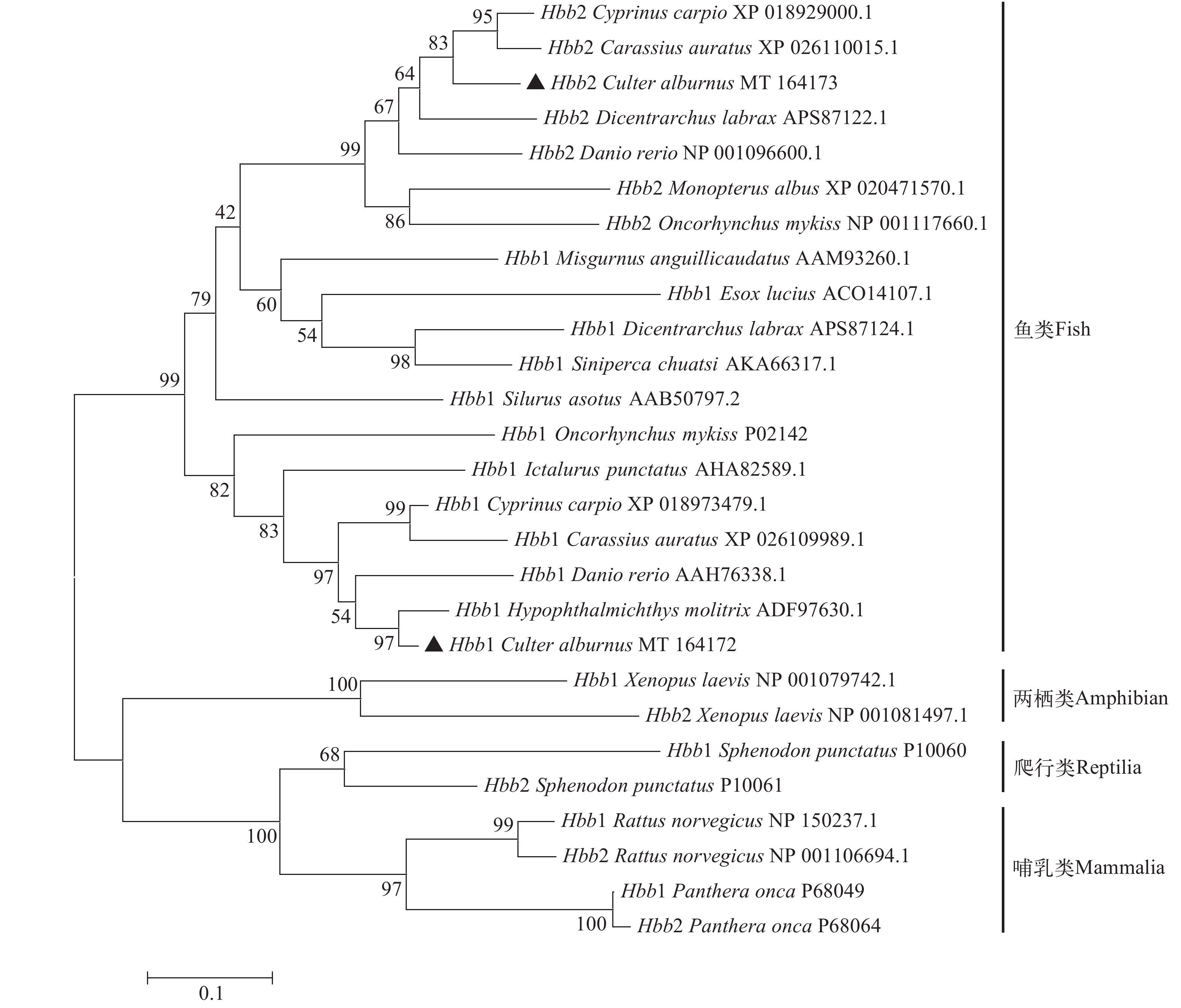CLONING, MOLECULAR CHARACTERISTIC AND PHYLOGENETICS OF HEMOGLOBIN GENES IN CULTER ALBURNUS
-
摘要: 研究通过克隆翘嘴鲌(Culter alburnus)血红蛋白基因, 分析血红蛋白的分子特征及系统进化, 探讨鱼类耐低氧的可能成因。研究克隆了翘嘴鲌血红蛋白家族中Hba1/2和Hbb1/2 cDNA序列, 翻译后分别得到143、143、147和147个氨基酸。蛋白二级结构分析表明Hba1/2和Hbb1/2蛋白分别包含7和8个螺旋域、14和13个α1β2结合残基、12和16个亚铁血红素结合残基, 均有16个α1β1结合残基, 只有Hba1/2蛋白具有6个Bohr效应残基。与两栖类和哺乳类相比, 鱼类Hba和Hbb蛋白功能域上分别有10和5个氨基酸残基替换位点, 这很可能是为了使其适应水中的低氧环境。而耐低氧与不耐低氧鱼类相比, 其蛋白二级结构并未发现一致性的替换, 这表明鱼类的耐低氧特征很可能是受到上游信号通路的调控。通过系统发育关系表明Hba1/2和Hbb1/2基因亚型的复制事件很可能发生在脊椎动物全基因组复制之后且硬骨鱼类全基因组复制事件之前。值得注意的是在系统进化树上, 与其他鱼类相比翘嘴鲌和斑马鱼在Hba1/2和Hbb1基因上有更近的亲缘关系, 这很可能是由于其同属鲤形目且均不耐低氧所致。研究首次克隆了翘嘴鲌血红蛋白家族基因, 分析其分子特征及与其他物种的系统发育关系, 并探讨了鱼类耐低氧的可能成因, 为鱼类的耐低氧生物学研究提供了理论基础与潜在方向。Abstract: Hemoglobin is one of the most important proteins for aerobic metabolism in vertebrate. The studies of Hb are more in Mammalia, but less in fishes with low-oxygen environment. This study cloned Hba1/2 and Hbb1/2 cDNA sequences of Culter alburnus (C. alburnus) hemoglobin, which encode 143, 143, 147 and 147 of amino acids, respectively. The second structure analysis of proteins indicated that Hba1/2 and Hbb1/2 included 7 and 8 helical regions, 14 and 13 α1β2 interfaces, 12 and 16 heme bindings, 16 and 16 α1β1 interfaces, respectively, and 6 Bohr effect residues only for Hba1/2. Compared with amphibians and mammalia, there were 10 and 5 amino acid substitutions in fishes of Hba and Hbb functional domains, which may be used to adapt to hypoxia. However, compared with tolerant and intolerant hypoxia fishes, we did not find any coherent substitution in the second structure of proteins, indicating that the tolerant hypoxia trait of fish may be regulated by upstream signal pathways. The phylogenetic relationship showed the duplication events of Hba1/2 and Hbb1/2 isoforms may occurre after vertebrate and before teleost of whole-genome duplications. Interestingly, in the phylogenetic trees, the genetic relationships of C. alburnus and Danio rerio of Hba1/2 and Hbb1 were closer than those of C. alburnus and other fishes, probably because both C. alburnus and Danio rerio belong to Cypriniformes and intolerant to hypoxia. This study cloned Hba1/2 and Hbb1/2 cDNA sequences of C. alburnus hemoglobin, analyzed molecular characteristics and phylogenetic relationships with others, and discussed the possible causes of fish tolerance to hypoxia. These findings provide a theoretical basis and potential direction for fish tolerant hypoxia biology.
-
-
图 1 翘嘴鲌Hba1和Hba2氨基酸序列与哺乳类、两栖类及其他硬骨鱼类比对分析
黑色阴影部分表示是相同的氨基酸残基。根据哺乳类的α球蛋白, 方框表示螺旋区域(A—H, 除了D)。功能残基的位置分别表示为α1β1结合残基(1)、α1β2结合残基(2)、亚铁血红素结合残基(h)和Bohr效应残基(b)。三角形表示氨基酸替换位点。上述氨基酸序列从GenBank/EMBL/UniprotKB中获得的登录号详见图 3
Figure 1. Alignment of C. alburnus amino Hba1 and Hba2 amino acid sequences with mammalia, amphibian and other teleosts
The black shade denotes the identical residues. According to mammalian α globins, the helical regions (A—H, except D) were outlined by boxes. The positions of functional residues are indicated by: α1β1 interfaces (1), α1β2 interfaces (2), heme binding (h), and Bohr effect residues (b). Triangles indicate changes at amino acids sites. Deduced amino acid sequences were obtained from GenBank/EMBL/UniprotKB, the accession numbers of which were dwelled on Fig. 3
图 2 翘嘴鲌Hbb1和Hbb2氨基酸序列与哺乳类、爬行类、两栖类及其他硬骨鱼类比对分析
黑色阴影部分表示是相同的氨基酸残基。根据哺乳类的β球蛋白, 方框表示螺旋区域(A—H)。功能残基的位置分别表示为α1β1结合残基(1)、α1β2结合残基(2)和亚铁血红素结合残基(h)。三角形表示氨基酸替换位点。上述氨基酸序列从GenBank/EMBL/UniprotKB中获得的登录号详见图 4
Figure 2. Alignment of C. alburnus amino Hbb1 and Hbb2 acid sequences with mammalia, reptilia, amphibian and other teleosts
The black shade denotes the identical residues. According to mammalian β globins, the helical regions (A—H) were outlined by boxes. The positions of functional residues are indicated by: α1β1 interfaces (1), α1β2 interfaces (2), and heme binding (h). Triangles indicate changes at amino acids sites. Deduced amino acid sequences were obtained from GenBank/EMBL/UniprotKB, the accession numbers of which were dwelled on Fig. 4
表 1 Hba1、Hba2、Hbb1和Hbb2基因克隆所需引物序列
Table 1 The primers used for the cDNAs cloning of Hba1, Hba2, Hbb1 and Hbb2 genes
引物Primer 序列Sequence (5′—3′) Primers for partial fragment Hba1-F TCTGATAAGKACAMGGCTGTT Hba1-R ATGCCCAATGCAGGWTTAG Hba2-F GAACSACAGTGGWGAAGGGAG Hba2-R CTGACCTGGRCGAGGAACT Hbb1-F GGCAAGGGTGCTGATTSTA Hbb1-R CAGCCTGAAGTTGWCTGRATC Hbb2-F TGAGAAGAYCACCATCCAG Hbb2-R GTTAAGCAGTCAGCCWAAA Primers for 3′ RACE PCR 3′ GS-Hba1 01-F AGAATGCTGACCGTCTACCC 3′ GS-Hba1 11-F GGTCTGGTCCTGTGAAGAA 3′ GS-Hba2 01-F CATTGGGCAGACCTAAACC 3′ GS-Hba2 11-F ACGACAGTGGTGAAGGGAG 3′ GS-Hbb1 01-F TCCAGGGCAATCCCAAGGT 3′ GS-Hbb1 11-F ACTGTGCTAAATGCGTTGG 3′ GS-Hbb2 01-F CTCTACAACGCCGCTGCTA 3′ GS-Hbb2 11-F GGACAACATCAAAGCCACC 3′ RACE Outer TACCGTCGTTCCACTAGTGATTT 3′ RACE Inner CGCGGATCCTCCACTAGTGATTTCACTATAGG Primers for 5′ RACE PCR 5′ GS-Hba1 01-F CCCACAAGGTCGTCTATTTT 5′ GS-Hba1 11-F AAAGCATGAAGTTCGCTCA 5′ GS-Hba2 01-F CTGACCTGGGCGAGGAACT 5′ GS-Hba2 11-F CTCCCTTCACCACTGTCGTTCCA 5′ GS-Hbb1 01-F TTCCAACGCATTTAGCACA 5′ GS-Hbb1 11-F GTTGTGCCACCTTGGGATT 5′ GS-Hbb2 01-F CATAGGTGGCTTTGATGTTG 5′ GS-Hbb2 11-F GATAGCAGCGGCGTTGTAG 5′ RACE Outer CATGGCTACATGCTGACAGCCTA 5′ RACE Inner CGCGGATCCACAGCCTACTGATGATCAGTCGATG Note: Mixed bases: B-G/T/C; D-G/A/T; H-A/T/C; K-G/T; M-A/C; R-A/G; S-G/C; V-G/A/C; W-A/T; Y-C/T 表 2 翘嘴鲌Hba1、Hba2、Hbb1和Hbb2基因的cDNA全长序列信息
Table 2 The information for full-length cDNA sequences of Hba1, Hba2, Hbb1 and Hbb2 from C. alburnus
基因Gence 长度Length (bp) 5′UTR (bp) 3′UTR (bp) ORF (bp) 氨基酸的数目
Number of amino acidsHba1 652 108 115 429 143 Hba2 465 21 15 429 143 Hbb1 477 21 15 441 147 Hbb2 475 18 16 441 147 表 3 翘嘴鲌Hba1、Hba2、Hbb1和Hbb2氨基酸序列与其他物种同源性(%)分析
Table 3 Identity analysis of C. alburnus Hba1, Hba2, Hbb1 and Hbb2 amino acid sequence with other species (%)
氨基酸Amino acid 斑马鱼Zebrafish 鲤Crap 非洲爪蟾Xenopus 大鼠Rat Hba1 93.0 68.5 44.8 51.0 Hba2 88.8 86.7 44.1 51.0 Hbb1 84.4 87.1 54.4 51.7 Hbb2 84.4 89.8 47.6 53.7 Note: GenBank/EMBL/UniprotKB databases accession numbers: Hba1 (Q90487, KTG39806.1, XP_018092516.1, NP_037228.1); Hba2 (NP_898889.2, KTF87195.1, NP_001081493.1, NP_001007723.1); Hbb1 (NP_001003431.1, XP_018973479.1, NP_001079742.1, NP_150237.1); Hbb2 (NP_001096600.1, XP_018929000.1, NP_001081497.1, NP_001106694.1). The order of accession numbers of each gene corresponds to zebrafish, crap, xenopus, and rat, respectively -
[1] Rombough P J. 2 Respiratory gas exchange, aerobic metabolism, and effects of hypoxia during early life [J]. Fish Physiology, 1988(11): 59-161.
[2] Koch L G, Britton S L. Aerobic metabolism underlies complexity and capacity [J]. The Journal of Physiology, 2008, 586(1): 83-95. doi: 10.1113/jphysiol.2007.144709
[3] Jensen F B, Fago A, Weber R E, et al. 1-hemoglobin structure and function [J]. Fish Physiology, 1998(17): 1-40.
[4] Nikinmaa M. Haemoglobin function in vertebrates: evolutionary changes in cellular regulation in hypoxia [J]. Respiration Physiology, 2001, 128(3): 317-329. doi: 10.1016/S0034-5687(01)00309-7
[5] Ingermann R L. Vertebrate hemoglobins [J]. Comprehensive Physiology, 2011: 357-408.
[6] Unwin E E. On the Structure of the Respiratory Organs of the Terrestrial Isopoda [C]. Papers and Proceedings of the Royal Society of Tasmania. Hobart, Tasmania: Royal Society of Tasmania, 1931: 37-104.
[7] Szarski H. The structure of respiratory organs in relation to body size in amphibia [J]. Evolution, 1964, 18(1): 118-126. doi: 10.1111/j.1558-5646.1964.tb01576.x
[8] Graham J B. Air-Breathing Fishes: Evolution, Diversity, and Adaptation [M]. San Diego: Academic Press, 1997: 65-133.
[9] Damen W G, Saridaki T, Averof M, et al. Diverse adaptations of an ancestral gill: a common evolutionary origin for wings, breathing organs, and spinnerets [J]. Current Biology, 2002, 12(19): 1711-1716. doi: 10.1016/S0960-9822(02)01126-0
[10] De Souza P C, Bonilla-Rodriguez G O. Fish hemoglobins [J]. Brazilian Journal of Medical and Biological Research, 2007, 40(6): 769-778. doi: 10.1590/S0100-879X2007000600004
[11] Hardison R C. A brief history of hemoglobins: plant, animal, protist, and bacteria [J]. Proceedings of the National Academy of Sciences of the United States of America, 1996, 93(12): 5675-5679. doi: 10.1073/pnas.93.12.5675
[12] Riggs A. Hemoglobins: current opinion in structural biology [J]. Current Opinion in Structural Biology, 1991, 1(6): 915-921. doi: 10.1016/0959-440X(91)90086-9
[13] Verde C, Lecointre G, Prisco G D, et al. The phylogeny of polar fishes and the structure, function and molecular evolution of hemoglobin [J]. Polar Biology, 2007, 30(5): 523-539. doi: 10.1007/s00300-006-0217-3
[14] Giardina B, Mosca D, De Rosa M C, et al. The Bohr effect of haemoglobin in vertebrates: an example of molecular adaptation to different physiological requirements [J]. Acta Physiologica Scandinavica, 2004, 182(3): 229-244. doi: 10.1111/j.1365-201X.2004.01360.x
[15] Antonini E, Brunori M. Hemoglobin and Myoglobin in Their Reactions with Ligands [M]. Amsterdam: North-Holland, 1971: 27-31.
[16] Hoffmann F G, Opazo J C, Storz J F, et al. Gene cooption and convergent evolution of oxygen transport hemoglobins in jawed and jawless vertebrates [J]. Proceedings of the National Academy of Sciences of the United States of America, 2010, 107(32): 14274-14279. doi: 10.1073/pnas.1006756107
[17] Storz J F, Opazo J C, Hoffmann F G, et al. Gene duplication, genome duplication, and the functional diversification of vertebrate globins [J]. Molecular Phylogenetics and Evolution, 2013, 66(2): 469-478. doi: 10.1016/j.ympev.2012.07.013
[18] Sato Y, Nishida M. Teleost fish with specific genome duplication as unique models of vertebrate evolution [J]. Environmental Biology of Fishes, 2010, 88(2): 169-188. doi: 10.1007/s10641-010-9628-7
[19] Kasahara M, Naruse K, Sasaki S, et al. The medaka draft genome and insights into vertebrate genome evolution [J]. Nature, 2007, 447(7145): 714-719. doi: 10.1038/nature05846
[20] Opazo J C, Butts G T, Nery M F, et al. Whole-genome duplication and the functional diversification of teleost fish hemoglobins [J]. Molecular Biology and Evolution, 2013, 30(1): 140-153. doi: 10.1093/molbev/mss212
[21] 张小谷, 熊邦喜. 翘嘴鲌的生物学特性及养殖前景 [J]. 河北渔业, 2005(1): 27-36. doi: 10.3969/j.issn.1004-6755.2005.01.012 Zhang X G, Xiong B X. The biological characteristics and breeding prospects of Culter alburnus [J]. Hebei Fisheries, 2005(1): 27-36. doi: 10.3969/j.issn.1004-6755.2005.01.012
[22] 朱华平, 黄樟翰, 谢刚, 等. 翘嘴红鲌鱼苗耗氧率和窒息点的初步研究 [J]. 水利渔业, 2003, 23(4): 5. Zhu H P, Huang Z H, Xie G, et al. The preliminary research on the oxygen consumption rate and the asphyxiant point of Erythroculter ilishaeformis fry [J]. Journal of Hydroecology, 2003, 23(4): 5.
[23] 陈松波, 范兆廷, 陈伟兴. 温度对鲤鱼窒息点的影响 [J]. 东北农业大学学报, 2007, 38(6): 801-804. doi: 10.3969/j.issn.1005-9369.2007.06.020 Chen S B, Fan Z T, Chen W X. The effect of temperature on the asphyxiant point of carp [J]. Journal of Northeast Agricultural University, 2007, 38(6): 801-804. doi: 10.3969/j.issn.1005-9369.2007.06.020
[24] 黄玉瑶. 鲤鱼, 白鲢, 鳊鱼的鱼苗, 鱼种耗氧量的研究 [J]. 动物学报, 1975, 21(1): 78-88. Huang Y Y. Oxygen consumption of the early developmental stages of the red and the common carp (Cyprinus carpio), the silver carp (Hypophthalmichthys molitrix) and the Chinese bream (Parabramis pekinensis) [J]. Current Zoology, 1975, 21(1): 78-88.
[25] 张中英, 胡玫, 吴福煌. 尼罗罗非鱼耗氧率的初步测定 [J]. 水产学报, 1982, 6(4): 369-377. Zhang Z Y, Hu M, Wu F H. Preliminary study on the oxygen consumption of Tilapia nilotica [J]. Journal of Fisheries of China, 1982, 6(4): 369-377.
[26] 杜启艳, 常重杰, 陈颖. 3种鲤科鱼β珠蛋白基因的比较研究 [J]. 水生生物学报, 2005, 29(1): 86-90. doi: 10.3321/j.issn:1000-3207.2005.01.016 Du Q Y, Chang Z J, Chen Y. Comparison of β globin gene in three fishes of cyprinoid [J]. Acta Hydrobiologicica Sinica, 2005, 29(1): 86-90. doi: 10.3321/j.issn:1000-3207.2005.01.016
[27] Chan F, Robinson J, Brownlie A, et al. Characterization of adult α- and β-globin genes in the zebrafish [J]. Blood, 1997, 89(2): 688-700. doi: 10.1182/blood.V89.2.688
[28] 邵占涛, 丛潇, 袁金铎, 等. 鲈α-珠蛋白基因的克隆和序列分析 [J]. 水产科学, 2009, 28(5): 268-271. doi: 10.3969/j.issn.1003-1111.2009.05.007 Shao Z T, Cong X, Yuan J D, et al. Cloning and sequence analysis of α-type globin cDNA from Japanese sea bass (Lateolabrax japonicus) [J]. Fisheries Science, 2009, 28(5): 268-271. doi: 10.3969/j.issn.1003-1111.2009.05.007
[29] Xia M Z, Chao Y, Jia J L, et al. Changes of hemoglobin expression in response to hypoxia in a Tibetan schizothoracine fish, Schizopygopsis pylzovi [J]. Journal of Comparative Physiology B-biochemical Systemic and Environmental Physiology, 2016, 186(8): 1033-1043. doi: 10.1007/s00360-016-1013-1
[30] Wang Z S, Qi Z T, Tian J Y, et al. Cloning of hemoglobin-α1 from half-smooth tongue sole (Cynoglossus semilaevis) and its expression under short-term hypoxia [J]. Zoological Research, 2011, 32(6): 641-646.
[31] 褚武英, 于涟, 毛芝娟, 等. 大黃鱼α-珠蛋白cDNA的克隆及其特性分析 [J]. 科技通报, 2005, 21(6): 674-678. Chu W Y, Yu L, Mao Z J, et al. Molecular cloning and characterisation of α-Globin cDNA from large yellow croaker, Pseudosciaena crocea [J]. Bulletin of Science and Technology, 2005, 21(6): 674-678.
[32] Perutz M F. Stereochemistry of cooperative effects in haemoglobin: haem-haem interaction and the problem of allostery [J]. Nature, 1970, 228(5273): 726-734. doi: 10.1038/228726a0
[33] Lawn R M, Efstratiadis A, Oconnell C, et al. The nucleotide sequence of the human β-globin gene [J]. Cell, 1980, 21(3): 647-651. doi: 10.1016/0092-8674(80)90428-6
[34] Miyata M, Aoki T. Head-to-head linkage of carp α- and β-globin genes [J]. Biochimica et Biophysica Acta, 1997, 1354(2): 127-133. doi: 10.1016/S0167-4781(97)00111-5
[35] Okamoto K, Sakai M, Miyata M, et al. Molecular cloning and sequence analysis of α- and β-globin cDNAs from yellowtail, Seriola quinqueradiata [J]. Comparative Biochemistry and Physiology B, 2001, 130(2): 207-216.
[36] Giordano D, Vergara A, Lee H C, et al. Hemoglobin structure/function and globin-gene evolution in the Arctic fish Liparis tunicatus [J]. Gene, 2007, 406(1-2): 58-68. doi: 10.1016/j.gene.2007.06.002
[37] Ohno S, Wolf U, Atkin N B, et al. Evolution from fish to mammals by gene duplication [J]. Hereditas, 2009, 59(1): 169-187. doi: 10.1111/j.1601-5223.1968.tb02169.x
[38] Hoffmann F G, Opazo J C, Storz J F. Rapid rates of lineage-specific gene duplication and deletion in the a-globin gene family [J]. Molecular Biology and Evolution, 2008, 25(3): 591-602. doi: 10.1093/molbev/msn004
[39] Hoffmann F G, Opazo J C, Storz J F. Whole-genome duplications spurred the functional diversification of the globin gene superfamily in vertebrates [J]. Molecular Biology and Evolution, 2012, 29(1): 303-312. doi: 10.1093/molbev/msr207
[40] 范能全, 张璞, 李丹, 等. 两种药物对斑马鱼呼吸代谢速率的影响 [J]. 中国药师, 2018, 21(2): 208-210. doi: 10.3969/j.issn.1008-049X.2018.02.005 Fan N Q, Zhang P, Li D, et al. Effects of two drugs on the respiration of zebrafish [J]. China Pharmacist, 2018, 21(2): 208-210. doi: 10.3969/j.issn.1008-049X.2018.02.005




 下载:
下载:


